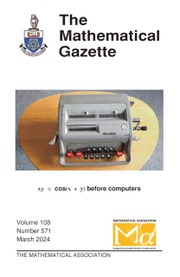No CrossRef data available.
Article contents
The most concise recurrence formula for the sums of integer powers
Published online by Cambridge University Press: 20 June 2025
Extract
For integers n,  , let Sk (n) denote the power sum 1k + 2k +… + nk, with S0 (n) = n. As is well known, Sk (n) can be represented by a polynomial in n of degree k + 1 with constant term equal to zero, i.e.
, let Sk (n) denote the power sum 1k + 2k +… + nk, with S0 (n) = n. As is well known, Sk (n) can be represented by a polynomial in n of degree k + 1 with constant term equal to zero, i.e.  ${S_k}\,(n)\, = \,\mathop \sum \nolimits_{j\, = \,1}^{k\, + \,1} \,{a_{k,j}}{n^j}$, for certain rational coefficients ak,j. In 1973, in the popular science magazine Kvant*, appeared an article by Vladimir Abramovich [1] in which, among other things, the author derived the following minimal recurrence relation which expresses in a very compact way the connection between the power sums Sk (n) and Sk-1 (n):
${S_k}\,(n)\, = \,\mathop \sum \nolimits_{j\, = \,1}^{k\, + \,1} \,{a_{k,j}}{n^j}$, for certain rational coefficients ak,j. In 1973, in the popular science magazine Kvant*, appeared an article by Vladimir Abramovich [1] in which, among other things, the author derived the following minimal recurrence relation which expresses in a very compact way the connection between the power sums Sk (n) and Sk-1 (n):
(1)
where the polynomial  $S_{k\, - \,1}^*\,(n)$ is constructed by replacing in Sk-1 (n) the term nj with the expression
$S_{k\, - \,1}^*\,(n)$ is constructed by replacing in Sk-1 (n) the term nj with the expression  ${{{n^{j + 1}} - n} \over {j + 1}}$ for each j = 1, 2, … , k. Note that
${{{n^{j + 1}} - n} \over {j + 1}}$ for each j = 1, 2, … , k. Note that  $S_{k\, - \,1}^*\,(n)$ has degree k + 1, as it should be.
$S_{k\, - \,1}^*\,(n)$ has degree k + 1, as it should be.
Information
- Type
- Articles
- Information
- Copyright
- © The Authors, 2025 Published by Cambridge University Press on behalf of The Mathematical Association


